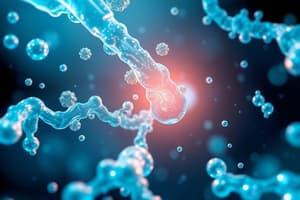Podcast
Questions and Answers
What is the primary purpose of homogenization in the context of protein extraction?
What is the primary purpose of homogenization in the context of protein extraction?
- To chemically modify proteins
- To enhance protein activity
- To break open the cellular structure (correct)
- To heat the protein solutions
Which technique is employed immediately after cells have been ruptured to help separate different components?
Which technique is employed immediately after cells have been ruptured to help separate different components?
- Differential centrifugation (correct)
- Filtration
- Electrophoresis
- Chromatography
Which statement is NOT true regarding the Potter-Elvehjem homogenizer?
Which statement is NOT true regarding the Potter-Elvehjem homogenizer?
- It is a thick-walled test tube system
- It allows for the removal of extracellular material
- It requires the use of high temperatures to function (correct)
- It uses a tight-fitting plunger to break cells
What alternative method can be used to rupture cells, as mentioned in the content?
What alternative method can be used to rupture cells, as mentioned in the content?
How does differential centrifugation assist in the purification of proteins?
How does differential centrifugation assist in the purification of proteins?
Flashcards
Homogenization
Homogenization
The process of breaking open cells to release their contents, often involving mechanical disruption with tools like a Potter-Elvehjem homogenizer.
Potter-Elvehjem homogenizer
Potter-Elvehjem homogenizer
A device used for cell disruption, consisting of a thick-walled test tube and a tight-fitting plunger, which forces cells through a narrow space, causing them to break open.
Differential centrifugation
Differential centrifugation
A technique used to separate cellular components by size and density using a series of centrifugations at increasing speeds.
Sonication
Sonication
Signup and view all the flashcards
Protein Purification
Protein Purification
Signup and view all the flashcards
Study Notes
Protein Purification and Characterization Techniques
- Many different proteins exist within one cell.
- Many techniques are used to remove contaminants and isolate pure protein samples.
- The first step is releasing proteins from cells and organelles.
- Homogenization breaks open cells.
Homogenization Techniques
- Potter-Elvehjem homogenizer: A thick-walled test tube with a tight-fitting plunger is used to break open cells. The tube is moved up and down to grind the tissues.
- Blending: Tissues are ground in a blender with a suitable buffer solution.
- Sonication: Sound waves are used to break open cells.
Differential Centrifugation
- To separate particles, ruptured cells are centrifuged multiple times.
- Increased gravitational force at each step allows for separation of different-sized particles, which form pellets of different cellular components at various spin speeds.
- Pellet 1: Nuclei and unbroken cells
- Pellet 2: Mitochondria, Lysosomes, Microbodies
- Pellet 3: Ribosomes, Microsomes (ER, Golgi, plasma-membrane fragments)
- Supernatant : The liquid part remaining after centrifugation
Studying That Suits You
Use AI to generate personalized quizzes and flashcards to suit your learning preferences.




